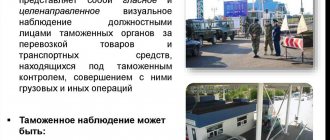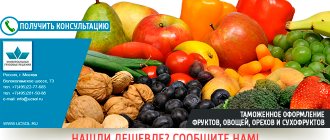Customs regulation and customs affairs
Module No. I. GENERAL PART OF CUSTOMS LAW
Topic 1. CONCEPT OF CUSTOMS AFFAIRS AND CUSTOMS LAW
Customs regulation and customs affairs
Customs policy is a system of economic, legal, organizational and other large-scale measures carried out by the state and aimed at regulating customs relations and realizing Russia’s domestic and foreign economic interests. It is an integral part of the foreign economic policy of each state and regulates the exchange of goods between countries (groups of countries), exerting economic and political influence on the markets of partner countries and on policies, including economic and trade.
After the formation of the CIS, the former republics of the USSR, which became independent states, sought to maintain a single customs space and form a Customs Union. The Customs Union is an economic association of states that have a single customs territory and a similar mechanism for regulating the economy, which is based on market principles of economic management and unified legislation. However, there were delays in the creation of the Customs Union on the territory of all CIS countries. Some states have withdrawn from the process. There were processes of differentiation within the Commonwealth, and the regulation of foreign economic relations was not uniform. Therefore, the creation of the Customs Union was suspended.
And only on October 6, 2008, a real step was taken towards the creation of a single customs space of the Eurasian Economic Community (EurAsEC) . The Presidents of the Russian Federation, the Republics of Belarus and Kazakhstan, by a decision of the Interstate Council (the highest body of the EurAsEC), stated the entry into force of the Agreement on the Commission of the Customs Union, as well as the Agreement on the creation of a single customs territory and the formation of the Customs Union of October 6, 2007. On November 27, 2009 in Minsk, at a meeting of the Interstate Council of the EurAsEC, the Agreement on the Customs Code of the Customs Union was signed, which marked the beginning of the functioning of the Customs Union on the territory of three states - Belarus, Russia and Kazakhstan. On January 1, 2010, the Customs Union began to operate, a new Unified Customs Tariff and a Non-Tariff Regulation System were introduced. Registration powers were transferred to a supranational body - the Customs Union Commission. In accordance with the Appendix to the Treaty on the Customs Code of the Customs Union, adopted by the Decision of the Interstate Council of the Eurasian Economic Community at the level of heads of state dated November 27, 2009 N 17 on the basis of Federal Law of the Russian Federation N 114-FZ dated June 2, 2010 “On the ratification of the Treaty on the Customs Code Customs Union”, on July 1, 2010, the Customs Code of the Customs Union (TC CU) was put into effect on the territory of the Russian Federation, the norms of which have direct effect. Until its repeal, the Customs Code of the Russian Federation is valid to the extent that does not contradict the Customs Code and is subject to application taking into account the changed basic terms and their definitions in accordance with the Customs Code.
Now manufacturers of the three CIS countries have the opportunity to move their goods without restrictions in the “triangle” of these countries. The creation of the Customs Union makes it possible to abandon all forms of state control at the border of Russia, Belarus and Kazakhstan. A new gigantic market has emerged, which has about 170 million consumers. Customs clearance of goods (now called “customs clearance” in the European Union) is moving to the borders of the Customs Union, which will lead to a reduction in paperwork and corruption charges. The concept of “domestic goods” gave way to “union goods,” that is, produced in the Customs Union. Kazakh and Belarusian producers will be considered domestic producers in Russia, and vice versa.
At first, the “allies” compiled a list of 400 imported goods that were “particularly sensitive” for countries. For example, Russia has kept low duties on imported medicines. And Belarus, on the contrary, defending its producers, defended high tariffs. To ensure that importers do not commit violations, that is, they declare in their documents a country where “preferential duty” is listed, but export it to a territory where the duty is high, the goods will be escorted to the place of customs clearance. This involves not only the presence of customs officers, but also special sealing of cargo and marks at checkpoints. If the importer violates the laws, his property may be seized and goods confiscated in the territory where he is detained.
Basic principles of the Customs Union:
– respect for the sovereign rights and equality of the Parties to the Union;
– compliance with the basic principles laid down in international norms of law assumed by the Parties to the Union;
– ensuring the economic security of each Party to the Union;
– ensuring the economic feasibility of the participation of each Party to the Union in the implementation of a unified customs regulation system;
– preservation, development and effective use of the positive experience of the customs services of the Parties to the Union;
– compliance with international law in the development and application of a unified customs regulation system.
The introduction of the Customs Code should strengthen the potential of the Union Parties to counter common economic threats, including those associated with the global financial crisis, and provide favorable conditions for the free movement of goods, capital and labor in a single customs territory.
The operation of the Customs Code of the Customs Union is intended to ensure the following in the single customs territory of the Customs Union:
– simplification of customs operations for participants in foreign trade activities, while strengthening customs control at the border of the union;
– uniform rules for customs valuation of goods, including those originating from third countries, taking into account WTO rules;
– unified rules for determining the country of origin of goods and a unified system of preferences in relation to third countries;
– uniform rules of tariff and non-tariff trade regulation measures (export, import and tariff quotas, licensing) in relation to third countries based on the rules and regulations of the WTO;
– a unified policy for collecting import and export duties on goods;
– transparency of the conditions for the transit of goods from third countries to third countries through a single customs territory, creating high competitive conditions in this area for the Parties to the union;
– functioning of a unified automated information system of customs services of the Parties to the Union;
– a uniform methodology for organizing and conducting customs control and a uniform composition of documents used;
– a unified system of statistical reporting on goods moved across the customs border of the union and its foreign trade;
– effective fight against smuggling;
– further development of highly professional customs personnel in accordance with international standards and requirements of the World Customs Organization.
The Federal Customs Service of the Russian Federation (FCS RF) has prepared a memo to customs authorities on the procedure for placing goods under the customs procedure and customs control of goods in the context of the functioning of the Customs Union within the framework of the EurAsEC ( Letter of the Federal Customs Service of the Russian Federation dated June 29, 2010 N 01-11/31846) . It states that the procedure for performing customs operations when importing goods into the single customs territory of the union and exporting them corresponds to the procedure currently applied in the Russian Federation. The main difference is that if foreign goods imported into any of the member states of the Customs Union and placed there under the customs procedure of release for domestic consumption, which provides for the goods receiving the status of “goods of the Customs Union”, with the exception of goods specified in the Protocol on Individual temporary exemptions from the operating regime of the single customs territory of the Union, receive the right to freely circulate throughout the customs territory of the Customs Union. The same right to freely circulate throughout the customs territory of the Customs Union from July 1, 2010 is given to goods originating from the Russian Federation, the Republic of Belarus and Kazakhstan, as well as goods that were recognized as domestic in the member states of the union on that date. Also considered, in particular: the procedure for declaring goods transported across the customs border; issues of classification of goods; determination of customs value and payment of customs duties; customs procedures.
The first months of the Customs Union have shown the costs associated with crossing the border, which leads to the refusal to locate new production facilities in Russia. Russia lags behind its alliance partners based on different ratings. In almost all surveys of international economic activity operators on the simplicity of customs procedures, our country is consistently in the second hundred. According to most ratings, alliance partners are higher. The percentage of physical inspection of cargo in the Russian Federation is 44%. While in the USA it is only 3%.
The Federal Law of the Russian Federation “On Customs Regulation in the Russian Federation,” which passed the first reading in the State Duma, should bring a certain customs liberalization. Its adoption is expected in October 2010. It will replace the Labor Code of the Russian Federation and regulate the norms that the Labor Code of the Customs Union were left at the national level and were not regulated by a supranational body. Along with the approval of the law, by-laws will be adopted to simplify customs procedures. The law provides for a reduction in the processing time for goods and the number of documents at the border. From the beginning of 2012, the Common Economic Space (SES) should be operational, which means a deeper degree of integration.
There are two main types of customs policies in the world: protectionism and free trade. Protectionism involves the establishment of a high level of customs taxation of foreign goods imported into the domestic market. The state puts barriers to the free penetration of imports into the domestic market, thereby protecting the interests of domestic producers.
There are hard, moderate and soft protectionism. Strict protectionism is characterized by high duties, an almost complete ban on imports, and incentives for exports. The disadvantage is that other countries are introducing similar measures. Moderate, or industrial, protectionism involves the admission of foreign goods to the domestic market, a reduction in customs duties, simplification of the procedure for the passage of goods across the border, and the conclusion of bilateral agreements on the provision of benefits. Soft protectionism consists in the fact that a country puts participants in special conditions, allowing them to import goods at low duties, which, as a rule, are not competitive in advance due to their low quality.
Free trade policies are aimed at encouraging the import of foreign goods into the country's domestic market by establishing a minimum level of customs duties or no customs duties at all. This policy is temporary, often simply forced.
Customs policy determines the main directions of customs regulation and customs affairs. The Constitution of the Russian Federation contains the concept of “customs regulation”. According to Part 1 of Article 1 of the Customs Code of the Customs Union, customs regulation consists of the legal regulation of relations related to the movement of goods across the customs border of the Customs Union, their transportation through a single customs territory under customs control, temporary storage, customs declaration, release and use in accordance with customs procedures, customs control, payment of customs duties, as well as power relations between customs authorities and persons exercising the rights to own, use and dispose of goods. Customs regulation is carried out in accordance with the customs legislation of the Customs Union, and in the part not regulated by it, in accordance with the legislation of the member states of the Customs Union.
To regulate international trade turnover, there are bodies governing foreign economic activity (FEA), in the system of which a special role is played by the service involved in customs affairs. Carrying out foreign economic activity is impossible without applying the basics of customs affairs.
According to Part 2 of Article 1 of the Labor Code of the Russian Federation, customs affairs is a set of methods and means of ensuring compliance with customs tariff regulation measures and prohibitions and restrictions established in accordance with the legislation of the Russian Federation on state regulation of foreign trade activities related to the movement of goods across the customs border. The elements of customs affairs include: customs operations, customs procedures, customs tariffs and customs statistics.
Customs operations are individual actions performed by persons and customs authorities in order to ensure compliance with the customs legislation of the Customs Union, and are applied regardless of the countries of origin, departure and destination of goods. Customs operations are divided into operations preceding the filing of a customs declaration, those performed at the places of arrival and departure of goods and after filing a customs declaration, payment of customs duties, implementation of customs control, release of goods and others.
Customs procedures are a set of rules that define, for customs purposes, the requirements and conditions for the use and (or) disposal of goods and vehicles in the customs territory of the Customs Union or beyond its borders.
The customs tariff is an instrument of trade policy and government regulation of the internal market of goods of the Customs Union in its relationship with the world market. As an element of customs affairs, it helps to determine the volume of customs duties payable by the subject of foreign trade activities.
The basis of the customs tariff is the Unified Commodity Nomenclature for Foreign Economic Activity of the Customs Union (TN FEACN of the Customs Union), which, in accordance with Art. 50 of the Customs Code of the Customs Union is used to implement measures of customs tariff and non-tariff regulation of foreign trade and other types of foreign economic activity, maintaining customs statistics. For each transported product, its classification code is determined, which affects the customs duty rate.
In order to analyze the state, dynamics and trends in the development of foreign trade in goods, customs authorities, in accordance with the methodology approved by the decision of the Commission of the Customs Union, collect and process information on the movement of goods across the customs border to generate data on customs statistics of foreign trade in goods (Article 47 of the Customs Code of the Customs Union ). Customs statistics data are provided by customs authorities:
– the government, bodies and organizations of the member state of the Customs Union in accordance with national legislation;
– international organizations in the manner established by international treaties of the member state of the Customs Union.
The Customs Union Commission publishes data on foreign trade statistics of the member states of the union. Customs authorities may provide statistical data that does not contain banking, commercial, state and other secrets protected by law or confidential information to organizations of a member state of the union interested in receiving them. According to Art. 48 of the Customs Code of the Customs Union, special customs statistics in accordance with the legislation of the member states of the union. For statistical purposes, documents and information provided by persons are used (Article 49 of the Labor Code of the Customs Union). The provisions of Article 8 of the Labor Code of the Customs Union apply to information used for statistical purposes.
The essence of customs affairs is determined by its main goals : protective, economic, social.
The protective goal is achieved by fulfilling the tasks of protecting state and public security and ensuring economic interests. For this purpose, legal means are used by which the state prescribes the rules of conduct of the parties to customs legal relations. For example, restricting the movement of goods across the customs border, customs control, etc.
The economic goal is predetermined by the special place in the field of customs affairs of customs payments. It is divided into two components: fiscal and regulatory, which complement each other and ensure the development of the national economy.
The fiscal beginning of the economic goal is to replenish the revenue side of the budget of the member states of the union, since one of its significant sources is payments in the field of foreign trade. In accordance with Art. 34 of the Tax Code of the Russian Federation, customs authorities enjoy the rights and bear responsibilities for collecting taxes and fees when moving goods and vehicles across the customs border.
The essence of the regulatory type of economic goal is that the state is interested not only in replenishing its treasury, but also in protecting domestic producers and creating a favorable climate for investment production.
The social goal is expressed in the fact that the Russian Federation and other countries of the Customs Union strive for active participation in international cooperation. Russia, being one of the 169 member states of the World Customs Organization, takes into account that the development of customs business is impossible without harmonization and unification with international norms and practices. Currently, work is underway to adapt the framework of standards for the security and facilitation of global trade adopted in 2005 at the 105/106 session of the Council of the World Customs Organization in the regulation of customs affairs.
Introduction to Customs Law
Definition 1
Customs law is a branch of Russian legislation, consisting of a system of legal norms and regulating social relations that are associated with the movement of goods and vehicles across the border.
Customs law is a complex field that includes provisions from many branches of law:
- international,
- constitutional,
- criminal,
- administrative,
- civil,
- financial


